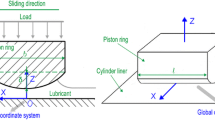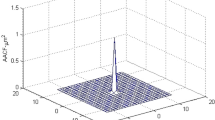Abstract
A method of using a quadratic function of rotary asperities to be equivalent to asperity is established based on a measurement experiment on rough surface topography. A micro-contact model of a rough surface that includes elastic, elastic-plastic, and pure plastic deformation states is re-derived using the theory of contact mechanics and the method of probability statistics. A rough surface contact stiffness model under mixed lubrication is proposed in accordance with the rough surface contact stiffness, which consists of solid surface and lubrication medium contact stiffness. The influence of the lubrication medium, solid material, and asperity size parameters on contact stiffness is analyzed. Results show that elastic modulus, acoustic impedance, and the size parameters of the asperities of the solid part are the main factors that affect the contact stiffness of the solid part. The acoustic impedance of the lubricating medium mainly affects the contact stiffness of the lubrication part. The contact stiffness of the rough surface under mixed lubrication is a superposition of the solid and lubrication parts, and it is greater than that without the lubrication medium. The model established in this study fully considers the deformation state in practical engineering, which includes asperities and the lubrication state of rough surfaces. It provides a reference for the performance prediction of mechanical surfaces.
Similar content being viewed by others
Abbreviations
- A :
-
Quadratic coefficient of the function
- a e :
-
Contact area at the elastic deformation stage per unit area
- Ae* :
-
Contact area at the elastic-plastic deformation stage
- a ep :
-
Contact area at the elastic-plastic deformation stage per unit area
- A ep*:
-
Contact area at the elastic-plastic deformation stage
- A n :
-
Nominal contact area
- a p :
-
Contact area at the stage of pure plastic deformation per unit area
- A p*:
-
Contact area at pure plastic contact deformation
- A s :
-
Contact area of the solid contact part
- B :
-
Cubic coefficient of the function
- c 1 :
-
Wave speed of ultrasonic waves on the upper surface materials
- c 2 :
-
Wave speed of ultrasonic waves on the lower surface materials
- d :
-
Contact gap
- d* :
-
Existing rough surface distance
- d 1 :
-
Average distance of the contact surface
- d 2 :
-
Average thickness of the liquid oil film layer
- E 1 :
-
Elastic moduli of the upper surface materials
- E 2 :
-
Elastic moduli of the lower surface materials
- f :
-
Frequency of ultrasonic waves
- F :
-
Total external load of the interface
- f e :
-
Contact load at the elastic deformation stage per unit area
- F e*:
-
Contact load at the elastic deformation stage
- f ep :
-
Contact load at the elastic-plastic deformation stage per unit area
- F ep*:
-
Contact load at the elastic-plastic deformation stage
- F l :
-
Lubricating medium pressure of the interface
- f p :
-
Contact load at the pure plastic deformation stage per unit area
- F p*:
-
Contact load under pure plastic contact deformation
- F s :
-
Contact load of the solid contact part
- h :
-
Height of the asperity
- H :
-
Hardness of softer materials
- k :
-
Coefficient of the maximum average contact pressure
- k e :
-
Contact stiffness at the elastic deformation stage per unit area
- K e*:
-
Contact stiffness at the elastic deformation stage
- k ep :
-
Contact stiffness at the elastic-plastic deformation stage per unit area
- K ep * :
-
Contact stiffness at the elastic-plastic deformation stage
- K l :
-
Contact stiffness of the lubricating medium
- k l :
-
Contact stiffness of the liquid lubricating layer per unit area
- k p :
-
Contact stiffness at the stage of pure plastic deformation per unit area
- K p*:
-
Contact stiffness under pure plastic contact deformation
- K s :
-
Contact stiffness of the solid contact part
- k s :
-
Contact stiffness of the solid contact part per unit area
- I :
-
Diameter of the asperity
- L :
-
Diameter of asperities
- n :
-
Asperities in the nominal contact area
- p e :
-
Elastic pressure
- p p :
-
Plastic pressure
- r :
-
Contact radius of the asperity
- R :
-
Hemisphere with an equivalent curvature radius
- Ra :
-
Surface roughness
- RC :
-
Ultrasonic reflection coefficient of solid-liquid contact
- r e :
-
Contact radius of the vertex contour of the asperity at the elastic deformation stage
- r p :
-
Contact radius of the asperities at the pure plastic deformation stage
- v :
-
Total Poisson’s ratio
- v 1 :
-
Poisson’s ratios of the upper surface materials
- v 2 :
-
Poisson’s ratios of the lower surface materials
- x :
-
Range of half of the positive and negative diameters of the asperities
- Z 1 :
-
Acoustic impedance of the solid part
- Z 2 :
-
Acoustic impedance of the lubricating medium
- β :
-
Surface morphology parameter
- δ :
-
Contact deformation
- δ c :
-
Deformation of the elastic yield point of the material
- δ p :
-
Deformation of the material at the point of pure plastic yield
- η :
-
Area density of the asperities
- λ :
-
Wavelength of ultrasonic waves in the lubricating medium
- λ 2 :
-
Sound wave wavelength in the liquid
- ρ 1 :
-
Density of the solid part
- ρ 2 :
-
Density of the lubricating medium
- σ :
-
Standard deviation of the height distribution of the rough surface
- σ s :
-
Standard deviation of the height distribution of asperities
- Φ(z) :
-
Probability density function of the height distribution of asperities
References
L. Li et al., A modified elastic contact stiffness model considering the deformation of bulk substrate, Journal of Mechanical Science and Technology, 34 (2) (2020) 777–790.
L. Li et al., A new contact model of joint surfaces accounting for surface waviness and substrate deformation, International Journal of Applied Mechanics, 11 (8) (2019) 1950079.
X. L. Tian et al., Contact stiffness model of mechanical rough surface considering the interaction of asperities, Journal of Mechanical Engineering, 53 (17) (2017) 149–159.
J. Liao et al., Interface contact pressure-based virtual gradient material model for the dynamic analysis of the bolted joint in machine tools, Journal of Mechanical Science and Technology, 30 (10) (2016) 4511–4521.
J. A. Greenwood and J. B. P. Williamson, Contact of nominally flat surfaces, Proceedings of the Royal Society of London, 295 (1442) (1966) 300–319.
W. R. Chang, I. Etsion and D. B. Bogy, An elastic-plastic model for the contact of rough surfaces, Journal of Tribology, 109 (2) (1987) 257–263.
Y. Zhao, D. M. Maietta and L. Chang, An asperity microcontact model incorporating the transition from elastic deformation to fully plastic flow, Journal of Tribology, 122 (1) (2000) 86–93.
L. Kogut and I. Etsion, A finite element based elastic-plastic model for the contact of rough surfaces, Tribology Transactions, 46 (3) (2003) 383–390.
R. L. Jackson and I. Green, A finite element study of elastic-plastic hemispherical contact against a rigid flat, Journal of Tribology, 127 (2) (2005) 343–354.
L. Li et al., A new modeling method for contact stiffness of mechanical rough surface, Journal of Mechanical Engineering, 56 (9) (2020) 162–169.
L. Gan et al., Elastic-plastic contact mechanics model of fractal rough surface, Journal of Applied Mechanics, 33 (5) (2016) 738–743.
L. H. Wang et al., Micro-contact model and contact characteristics of mechanical rough surface, Mechanical Design and Research, 31 (4) (2015) 69–74.
J. Liu and Y. Shao, An improved analytical model for a lubricated roller bearing including a localized defect with different edge shapes, Journal of Vibration and Control, 24 (17) (2018) 3894–3907.
X. P. Li et al., Equivalent model study of generalized gap on rough surface, Journal of Vibration Engineering, 27 (1) (2014) 25–32.
H. F. Xiao et al., Calculation model and characteristics of normal contact stiffness of rough interface under mixed lubrication, Vibration and Shock, 37 (24) (2018) 10.
Q. An et al., Micro-contact model of plane grinding rough surface, Journal of Mechanical Engineering, 56 (7) (2020) 240–248.
R. Hill, The Mathematical Theory of Plasticity, Clarendon Press, Oxford (1950).
D. Tabor, The Hardness of Metals, Oxford University Press, Oxford (1951).
K. Xu, Y. Yuan and L. Zhang, A normal contact stiffness model of joint surface based on fractal theory, Computer Modeling in Engineering and Sciences, 119 (3) (2019) 459–479.
L. Li et al., Study on the normal contact stiffness of joint surface under mixed lubrication, Vibration and Shock, 39 (3) (2020) 16–23.
Z. Q. Gao et al., Study on energy consumption of side contact of elastic-plastic asperities during normal loading-unloading process, Journal of Mechanical Engineering, 54 (1) (2018) 150–160.
K. L. Johnson, Contact Mechanics, Cambridge University Press, London (1985).
D. Wang et al., Normal contact model for elastic and plastic mechanics of rough surfaces, Acta Mechanica Solida Sinica, 32 (2) (2019) 148–159.
H. F. Xiao, Y. Y. Sun and J. W. Xu, Normal elastic-plastic contact model of rough interface with continuous, monotonous and smooth stiffness change, Journal of Central South University (Natural Science Edition), 50 (6) (2019) 1343–1350.
Y. W. Zhao, Y. M. Lu and J. Z. Jiang, A new elastic-plastic contact model of rough surface, Journal of Mechanical Engineering, 43 (3) (2007) 95–101.
K. L. Johnson, J. A. Greenwood and S. Y. Poon, A simple theory of asperity contact in elastohydro-dynamic lubrication, Wear, 19 (1) (1972) 91–108.
J. Krautkramer and H. Krautkramer, Ultrasonic Testing of Materials, Springer Science and Business Media, New York (2013).
H. G. Tattersall, The ultrasonic pulse-echo technique as applied to adhesion testing, Journal of Physics D: Applied Physics, 6 (7) (1973) 819–832.
X. B. Lu, M. M. Khonsari and E. R. M Gelinck, The stribeck curve: experimental results and theoretical prediction, ASME Journal of Tribology, 128 (2006) 789–794.
Acknowledgments
This work was supported by the National Natural Science Foundation of China (Grant Number 51975449) and Key Research and Development Program of Shaanxi (Grant Number 2021GY-309). The authors are grateful to the other participants of the project for their cooperation.
Author information
Authors and Affiliations
Corresponding author
Additional information
Ling Li is an Associate Professor in the School of Mechanical and Electrical Engineering, Xi’an University of Architecture and Technology. He graduated from Beijing University of Technology with a Ph.D. in Mechanical Engineering. His research interests include machine dynamics, mechanical behavior of bolted joints and interfaces of critical structures, non-linear mechanics, and accuracy design of machine tools.
Rights and permissions
About this article
Cite this article
Li, L., Sun, L., Wang, J. et al. Contact modeling and stiffness of a rough surface under mixed lubrication condition. J Mech Sci Technol 37, 851–864 (2023). https://doi.org/10.1007/s12206-023-0127-0
Received:
Revised:
Accepted:
Published:
Issue Date:
DOI: https://doi.org/10.1007/s12206-023-0127-0




